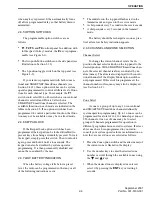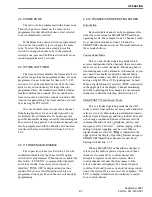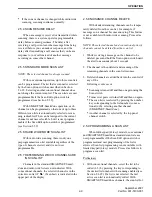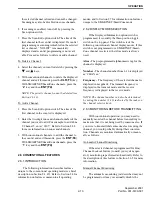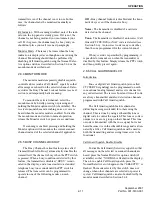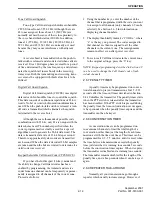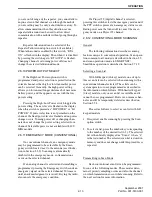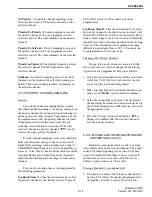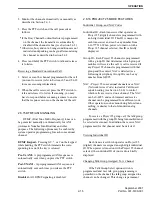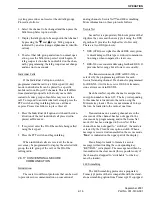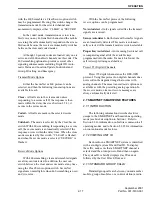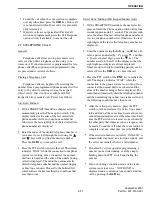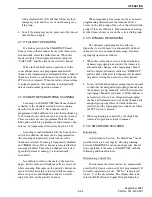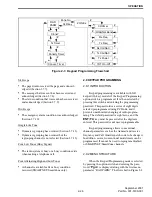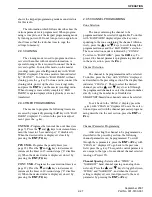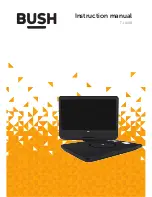
OPERATION
2-12
September 2001
Part No. 001-5100-001
Tone Call Guard Squelch
Tone-type Call Guard squelch utilizes subaudible
CTCSS tones from 67-254.1 Hz. Although there are
42 tones assigned, those above 33 (210.7 Hz) are
normally not used because of their close proximity to
the voice band which starts at 300 Hz. In addition,
tones 11 (97.4 Hz), 39 (69.3 Hz), 40 (206.5 Hz), 41
229.1 Hz), and 42 (254.1 Hz) are normally not used
because they may cause interference with adjacent
tones.
A reverse burst is transmitted when the push-to-
talk switch is released and also detected when calls are
received. It is a 180-degree phase reversal for a period
of time determined by the tone frequency, and it elimi-
nates the squelch tail (noise burst) in the receiving
transceiver. Both the transmitting and receiving trans-
ceiver must be equipped with this feature for it to be
utilized.
Digital Call Guard Squelch
Digital Call Guard squelch (CDCSS) uses digital
data instead of subaudible tones to control the squelch.
This data consists of continuous repetitions of 23-bit
words. No bit or word synchronization information is
used. When the push-to-talk switch is released, a turn-
off code is transmitted which eliminates the squelch
tail similar to the reverse burst.
Although there are thousands of possible code
combinations with 23 bits, only 83 are unique with the
data scheme used. The number specified when the
code is programmed is actually a seed for a special
algorithm used to generate the 23-bit data word. The
data is transmitted at a rate of 134.4 bits per second.
Therefore, approximately six words are transmitted
each second. When the data is decoded, 23-bit samples
are taken and then the bits are rotated to determine if a
valid code was received.
Keypad Selectable Call Guard Code (CTCSS/DCS)
If you have the full keypad (18-key) model and
the ability to change Call Guard codes has been
enabled by programming, the transmit and receive
codes from one channel can be temporarily or perma-
nently reassigned to all channels of the current zone.
Proceed as follows:
1. Using the number keys, enter the number of the
channel that is programmed with the code you want
to reassign to all channels (only channels 1-9 can be
selected). See Section 2.6.2 for information on
displaying channel numbers.
2. The display then briefly indicates “CODE x”, where
“x” is the key you pressed. The codes assigned to
that channel are then reassigned to all the other
channels in the current zone. The reassignments
remain in effect even after power is cycled.
3. To restore all Call Guard codes in the current zone
to the original settings, press the “0” key.
NOTE: Keypad programming described in Section 2.9
can be used to change the Call Guard code of indi-
vidual channels.
2.6.7 PENALTY TIMER
A penalty timer may be programmed on conven-
tional channels to prevent transmissions for 15 - 225
seconds after the time-out timer described in Section
2.4.10 disables the transmitter. The penalty timer starts
when the PTT switch is released after the transmitter
has been disabled. If the PTT switch is pressed during
the penalty time, the time-out indication occurs again.
A beep sounds when the penalty timer expires and the
transmitter can then be keyed.
2.6.8 CONVERSATION TIMER
A conversation timer can be programmed on
conventional channels to limit the total length of a
conversation rather than just the length of each trans-
mission as with the time-out timer. This timer can be
programmed for 0.5 - 7.5 minutes, and it is reset when
the time between transmissions exceeds the penalty
time just described. A warning tone sounds 5 seconds
before the conversation timer expires. When it expires,
the transmitter is disabled and a warning tone sounds.
The transmitter remains disabled for the length of the
penalty time, and a beep sounds when it can be keyed
again.
2.6.9 REPEATER TALK-AROUND
Normally, all your transmissions go through a
repeater which usually increases range. However, if









